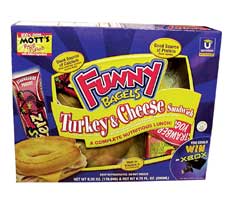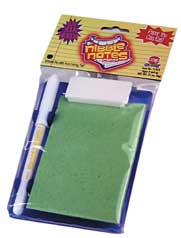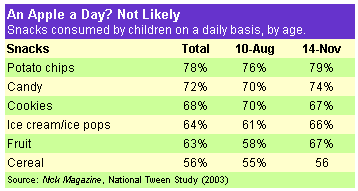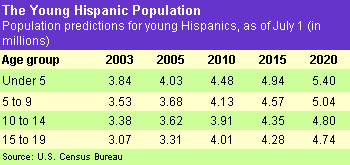
The food industry spends an estimated $13 billion a year marketing to children, says Marion Nestle, chair of the Department of Nutrition and Food Studies at New York University (New York). Food product ads make up about half of all commercials aimed at kids. Overall, the American Academy of Pediatrics (Elk Grove Village, Ill.) estimates the typical American child sees 20,000 ads a year.
While this may seem overwhelming, it also helps make the Millennials (those born somewhere between 1986 and 2001) a more-discerning group, believes consumer analyst Marcia Mogelonsky (Utica, N.Y.). “Having so many product choices and media choices makes them more aware of foods and snacks and the great availability of stuff out there. The current generation wants the latest, newest, best. The RPM of food development is so much faster than it was in past generations that there is a constant desire for something new.”

Licensed to Drive...Sales
Creating new products for children often is hit-and-miss. One frequently implemented strategy has been licensing well-known characters and franchises. However, this also has its pitfalls.“Manufacturers fail when promotions are not tightly linked to the equity of the product,” says Jennifer Goodman, managing director with the Geppetto Group (New York). “Because licensing is such a big part of kids marketing, one of the things we have found is that any company's promotion has to be linked to the product and made ownable to the manufacturer.”
One company hoping to do just that is Wells Dairy (Le Mars, Iowa). Its Blue Bunny brand has signed a 15-year license agreement with Disney for products based on a wide range of the company's trademarks. In developing the lineup of products, Blue Bunny has worked to create unique items, not just new packaging on an already-existing product.
According to Wells Dairy's executive vice president Mike Wells, “When we looked at Disney and worked with them to create this product line, one of the things that came through loud and clear was 'This isn't a typical license.' This wasn't a situation where you take a half-gallon of vanilla or fudge ripple and just put 'Disney' on it. The license gives access to the majority of characters (Mickey & Friends, Pooh & Friends, Monsters Inc., Toy Story, the princesses). We also have access to ESPN and X Games, and we see that as a really exciting segmentation as we start to look at how we address the Tween market.”
While Wells Dairy may not have had time to devote to the Tween concepts initially (the product licenses were signed in November of 2002 and products hit shelves by April 2003), they have plans to develop the X Games concept into a segment of products marketed “to kids, for kids.” Products are still in the early stages of development, but Wells notes that the line will center on “extreme sports, more interactive products, things that excite kids in that age range.”
Among the “Disney presented by Blue Bunny” products, Swirl'n Magic is a yogurt attempting to appeal to kids and, to a degree, parents. Parents long have regarded yogurt as a reasonably healthful snack, and the Swirl'n Magic line takes the healthful slant a bit further by sweetening with sucralose, allowing it to boast “50% less sugar than other leading brands of kids' yogurt.” (Actually, according to the company, everything in Wells Dairy's sugar-free line has been converted to sucralose.)
The real selling point for the kids is the interactivity of the product, allowing children to make a product their own, to have some ownership over it, believes Goodman. The interactive element of Swirl'n Magic is a packet under the lid that contains a powder and pop rocks, the source of the only sugar in the product. Once this is mixed in, the product changes color.

'Tween Right and Wrong
Dairy Queen (Edina, Minn.) also has noticed the trend of kids favoring foods that change color and sparkle, and is using that research to guide its R&D department in developing a new Tween treat (Tweens are between 11 to 14 years old).To market the products to the Tweens, Dairy Queen worked with G Whiz (New York). Terrie Kendall, senior design manager with G Whiz, discovered some notable traits about them. “Tweens don't like graphics that look too juvenile. I tried to develop characters that look cool, stylish and hip. Tweens have grown out of the soft pastels, which are generalized as being for babies. I concentrated on a palette of purples, aquas, citrus greens, tangerines and fresher reds."
One long-standing Dairy Queen tradition will not be seen in any new campaigns, however. Their license agreement with Dennis the Menace expired at the end of 2002, and the decision was made not to renew it. Quite simply, Dairy Queen found that Dennis and his gang no longer resonated with today's young person and—as Goodman relates—in kid marketing, a company has to be aware of what is going on now, what the latest fashionable trend is among kids.
In Zone Brands (Austell, Ga.) is well aware of this when introducing new additions to its line of Belly Washers and Tummy Ticklers. Each of the products is designed as an interactive beverage, with a licensed or familiar character atop the container. Licensed characters old and new, such as those from the Simpsons, Sesame Street, Barney, the Incredible Hulk and Scooby-Doo have been featured. The beverages offer interactivity, play value, reusability and are collectible. In Zone's challenge has been keeping the items fresh and up to date.
Kathy VerEecke, vice president of marketing, In Zone Brands, notes, “We have great relationships with (movie and television) studios that allow us the use of the license and a look at other potential opportunities. We are continually made aware of upcoming properties, upcoming movie deals, promotional deals, characters in the works that will launch two years from now, so that we can decide whether it would work in our portfolio.”
Belly Washers target 6- to 12-year-olds, while Tummy Ticklers are for 1- to 5-year-olds, but there are other differences between the two. The top of the Tummy Ticklers features a one-way, patented, no-spill valve that essentially acts like a sipping cup, and the bottle is shaped for younger, smaller hands. Plus, whereas Tummy Ticklers are 100% juice with no added color or preservatives, Belly Washers are a juice drink fortified with 100% vitamin C.
Belly Washers are considered a treat, but Tummy Ticklers add a nutritional element as well. In Zone wanted a product that was 100% juice, with no added color, preservatives or artificial flavors. Nutrition is playing a major role in parents' decisions about the foods their children eat, and no wonder. The U.S. Surgeon General found that 13% of 6- to 11-year-olds are overweight, a trait shared by 14% of adolescents aged 12-19, nearly triple the number of two decades ago.

Getting Fit!
One line of products to address these concerns with convenient meal items is Fit!, which launched June 1 from Medifast (Owings Mills, Md.). Designed to help children manage their weight and/or maintain good nutrition, the line is comprised of three products—a RTD chocolate shake and two energy/nutrition bars in chocolate or peanut butter flavors. Individually, the products are intended as a snack. A shake and a nutrition bar together would be a meal replacement, says the company.
“The trends in nutrition,” says Joe DiBartolomeo, vice president of clinical affairs, Medifast, “show kids don't eat breakfast, eat high-sugar snacks, and the school meals are often too high in fat. They are not eating in a way that is going to promote good nutrition. Fit!'s main ingredient is soy protein, a heart-healthful form of protein. We provide more than 6.25g of soy protein per serving, considered a heart-healthy amount of protein, and no cholesterol. Soy is good for bone growth, together with calcium (35% of daily requirement) and magnesium (50% of daily requirement); it is going to help with bone growth and healthy nerve function.”

Website Resources
www.stayfreemagazine.org/archives/13/kline.html— aA discussion of the world of licensed character marketingwww.zillions.org/research.htm— Article focusing on the growth of marketing to children at schools
www.mothering.com/10-0-0/html/10-3-0/10-3-whine97.shtml— Mothering magazine's look at corporate advertising to kids
www.thestandard.com/article/display/ 0,1151,2720,00.html— "Marketing to Children Online Isn't Child's Play"

Sidebar: An “Hola” New World
The Department of Census estimates the number of young Hispanics (those aged 5 to 13) at 6.3 million as of July 1, 2003. By July 1, 2020, that number is expected to be 8.9 million, with the total population of Hispanics in the U.S. at 55.2 million. The buying power of such a group will be enormous, but their true power could be in their influence.It already is evidenced in the growing number of Hispanic-style lunches on school menus, says consumer analyst Marcia Mogelonsky (Utica, N.Y.). To get a better idea of the changing tastes and influences on the palates of today's young people, she advises manufacturers to look to school lunch menus around the country, which must appeal to a broad range of people.
Mogelonsky, a speaker at September's upcoming Prepared Foods New Products Conference, believes the growth in ethnic foods on lunch menus is simply a reflection of the mixed ethnicities of school districts. Plus, kids who bring their lunch to school are having an impact on the dining preferences of their schoolmates.
To gauge future eating preferences of young Hispanics, Mongelonsky cites research she has done with Asian Indians in the U.S. “Regardless of the parents' food traditions,” she found, “the kids were desperate for McDonald's. Kids didn't want to be Asian Indian-American; they wanted to be American. I remember a mother commenting that she tried to teach her kids about the food of their country and curry, etc., and the kids always wanted McDonald's or KFC. So, it depends on how much force the Hispanic kids will exert in the household and if that will change the way the people eat.”

Mogelonsky will be speaking on "The Hidden Baby Boomers—Hispanic Trends" at the Prepared Foods' New Products Conference in September. For more information, contact Marge Whalen at 630-694-4347 or e-mail whalenm@bnp.com.
